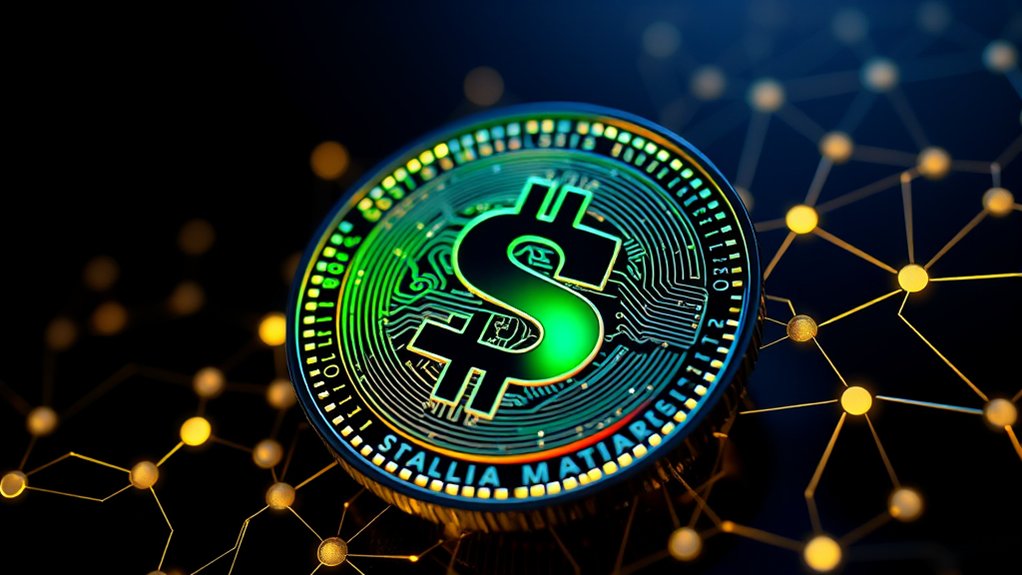SOL is the cryptocurrency backing Solana, a super-fast blockchain platform that’s trying to shake up decentralized finance, NFTs, and gaming. With a wild claim of handling up to 65,000 transactions per second, it’s hard to ignore. Solana uses a fancy combo of proof of history and proof of stake for efficiency. Sure, it’s had its share of outages that make you raise an eyebrow, but hey, the tech is still worth checking out for what’s next.

In the fast-paced world of cryptocurrency, Solana has emerged as a powerhouse, and not just because of its flashy name. It’s a serious player that promises high transaction speeds and decentralization. Solana isn’t just another coin; it’s a crypto computing platform that combines proof of history and proof of stake mechanisms. What does that mean? Efficiency. Pure and simple.
SOL, the native cryptocurrency of this platform, is used for everything from transaction fees to staking. Think of it as the lifeblood of the Solana ecosystem. With a focus on decentralized finance (DeFi), non-fungible tokens (NFTs), and gaming, Solana is not just sitting around. It’s out there pushing boundaries, and, let’s face it, it can process up to a whopping 65,000 transactions per second—that’s faster than you can say “Ethereum,” which, by the way, has a reputation for being slower and more expensive.
The consensus mechanisms at play—proof of history (PoH) and proof of stake (PoS)—work like a well-oiled machine. They timestamp events and validate transactions more quickly than you can refresh your social media feed. As of October 31, 2023, Solana has processed approximately 250 billion transactions, showcasing its significant usage. Additionally, the platform’s unique hybrid consensus model allows for unprecedented scalability and efficiency.
And don’t forget about Tower BFT and pBFT, which add another layer of security and fault tolerance. Scalability? Solana’s got it in spades.
The blockchain architecture is decentralized and open-source, which means anyone can jump in and develop. With programming languages like Rust, C, and C++, developers can create smart contracts that run without a hitch. This isn’t just a tech playground; it’s a serious platform for building decentralized applications.
But let’s not sugarcoat it. Solana has faced its share of reliability issues, including outages that made the headlines.
Still, it continues to push forward. Despite these hiccups, Solana’s potential makes it a cryptocurrency to watch. In the wild world of crypto, it’s carving out its niche, one transaction at a time.
Frequently Asked Questions
How Can I Buy SOL Cryptocurrency?
Buying SOL is pretty straightforward, really.
First, pick a platform like Gemini or Kraken. Sign up, verify your identity—because, apparently, they need to know it’s really you. Link a payment method, and boom! You can place your order.
Want to keep it safe? Consider a cold wallet or a hot wallet if you’re feeling adventurous.
Just remember, crypto isn’t exactly a walk in the park. Happy trading!
What Wallets Support SOL Storage?
When it comes to storing SOL, users have options—lots of them.
Phantom and Solflare are big players; they’re non-custodial and let you control your keys.
Brave Wallet is also in the mix, offering a smooth ride.
For a more secure route, there’s hardware like Ledger. It keeps those private keys safe from online creeps.
Custodial wallets? Sure, exchanges like Coinbase manage keys, but do you really want to hand over control?
What Are the Transaction Fees for SOL?
Transaction fees on the Solana network? They’re shockingly low.
Think around $0.0012 per transaction. Yep, you heard that right. Most transactions won’t cost more than fifty cents.
Plus, there are those extra prioritization fees—about $0.03111—if you want your transaction sped up.
But hey, compared to Ethereum’s crazy fees, Solana feels like a bargain. It’s like finding a dollar in your old coat pocket. Who doesn’t love that?
Is SOL a Good Investment?
Is Sol a good investment? Well, that’s the million-dollar question, isn’t it? Prices jump, drop, and do a little dance—like a confused toddler.
Sure, it’s fast and cheap, but volatility? Oh boy! It’s like riding a rollercoaster without a safety bar. Some folks see potential, while others clutch their wallets in fear.
Regulatory changes could swing the pendulum either way. So, buckle up, because with Sol, it’s a wild ride ahead!
How Does SOL Compare to Ethereum?
When comparing SOL to Ethereum, it’s like apples and oranges.
Sure, both are platforms for dapps and smart contracts, but Solana’s speed—50,000 transactions per second—makes Ethereum look like it’s stuck in traffic.
Ethereum’s been around longer, building a massive community, while Solana’s still the new kid on the blockchain.
And don’t forget their consensus methods: Solana’s Proof of History is a wild ride compared to Ethereum’s complicated PoS upgrade.
Simple versus complex, folks!





